The Karelian Bear Dog, with its striking black and white coat resembling the harmony of yin and yang, is a breed that piques curiosity and captures attention. But what lies beneath this visually captivating exterior? What makes the Karelian Bear Dog unique and worth exploring further?
In this discussion, we will uncover the origin and physical characteristics of this breed, delve into the adaptability and living arrangements that best suit them, and explore the various considerations and interactions that come with owning a Karelian Bear Dog.
So, let's embark on this journey to unravel the mysteries of this fascinating breed and discover what makes them truly remarkable.
Key Takeaways
- Karelian Bear Dogs are active and high-energy breeds that require regular exercise and thrive in homes with yards or access to outdoor areas.
- They may not be suitable for apartment living due to their moderate energy levels and the need for regular exercise within limited space.
- Karelian Bear Dogs are affectionate with family members and good with proper socialization and training, but may not be suitable for inexperienced dog owners or families with small children or other pets.
- Consistency, structure, early socialization, and positive reinforcement techniques are important for training Karelian Bear Dogs and establishing strong and confident leadership.
Origin and Physical Characteristics
Where did the Karelian Bear Dog originate and what're its physical characteristics?
The Karelian Bear Dog, also known as the Karjalankarhukoira, originated in Finland. This medium-sized breed falls under the Spitz group and has a lifespan of 10 to 12 years. It's known for its short, dense double coat, which typically comes in black and white.
The Karelian Bear Dog is adaptable to apartment living, as long as its energy levels and space requirements are considered. While it's affectionate with its family and gets along well with proper socialization and training, it may not be suitable for inexperienced dog owners or families with small children or other pets.
This breed requires strong leadership and continued training throughout its life.
Adaptability and Living Arrangements
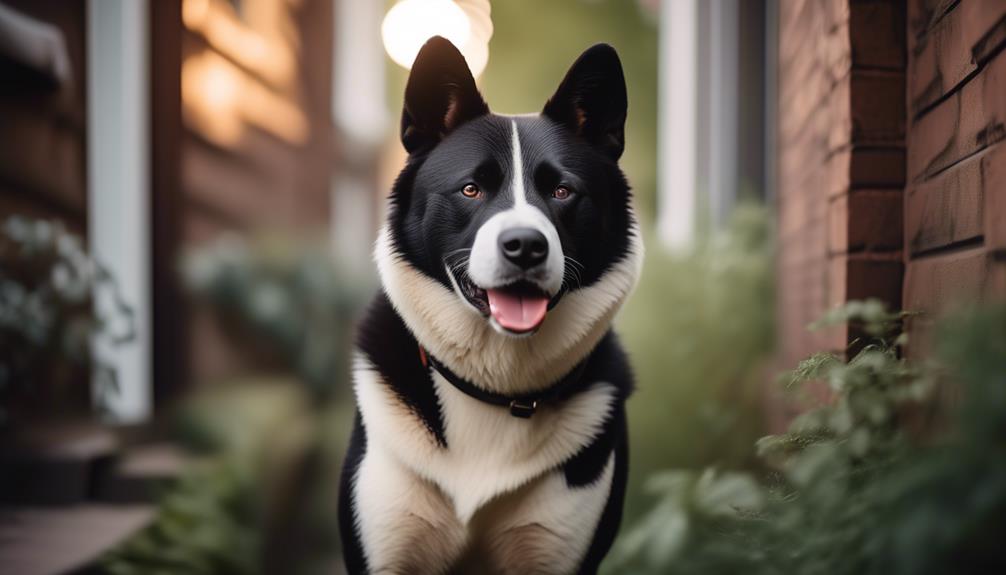
The Karelian Bear Dog's adaptability and suitability for different living arrangements depend on its energy levels and space requirements. Here are some key factors to consider:
- Energy levels: The Karelian Bear Dog is an active and high-energy breed. They require regular exercise to stay mentally and physically stimulated. A living arrangement that provides ample space for them to run and play is ideal.
- Space requirements: Due to their medium size and active nature, Karelian Bear Dogs may not be well-suited for small apartments or confined living spaces. They thrive in homes with yards or access to outdoor areas where they can explore and burn off energy.
- Quiet and well-behaved: When living in close quarters, it's important to prioritize qualities such as being quiet, low-energy, and well-behaved. Proper training and socialization can help create a harmonious living environment for everyone involved.
- Consideration for others: When choosing a dog for an apartment, it's essential to consider the needs and preferences of neighbors and housemates. The Karelian Bear Dog's tendency to bark or howl should be taken into account to ensure a peaceful living environment.
Considerations for Apartment Living
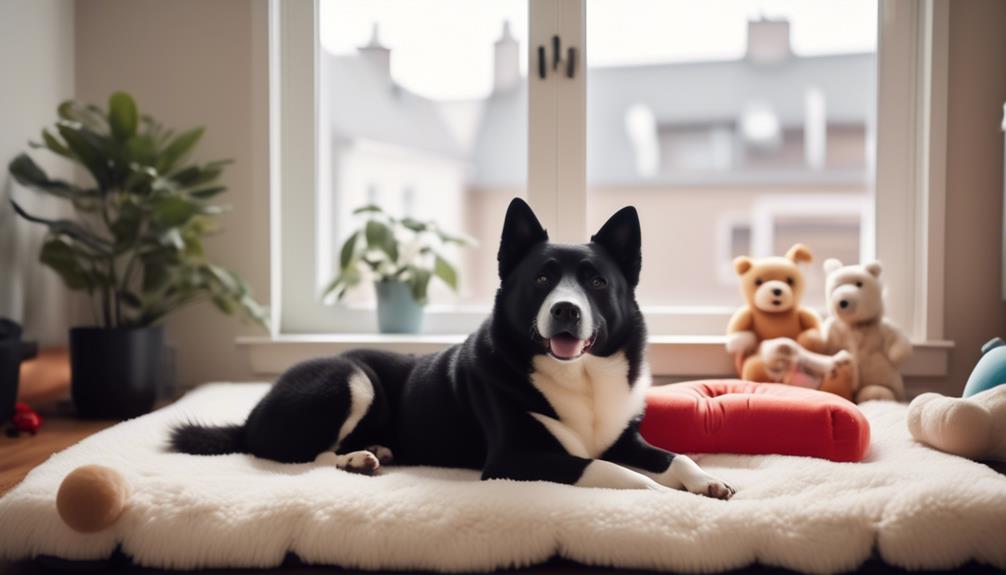
When considering apartment living, it's important to take into account the specific needs and characteristics of the Karelian Bear Dog.
While this breed can adapt well to apartment living, there are certain factors to consider. The Karelian Bear Dog has moderate energy levels and requires regular exercise, so it's important to provide enough physical activity within a limited space.
Additionally, qualities such as being quiet, low-energy, and well-behaved should be prioritized when choosing a dog for apartment living. It's important to create a harmonious living environment for both the dog and the apartment residents.
Due to their strong predatory instincts, this breed may not be suitable for families with small children or other pets. Strong leadership and continued training throughout their life are necessary to manage their potential aggression and wandering tendencies.
Friendliness and Socialization
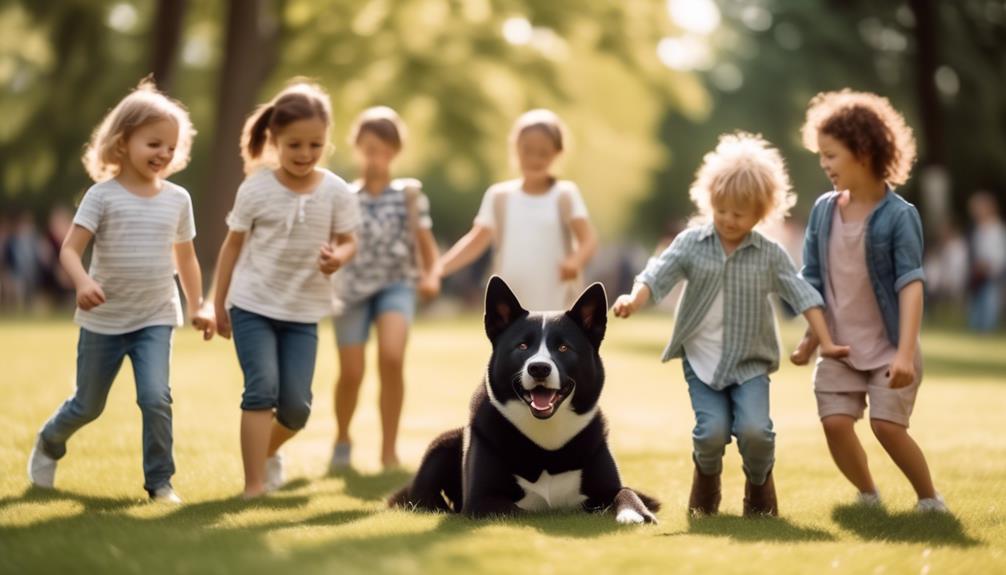
The Karelian Bear Dog displays friendliness and sociability when properly socialized and trained. Here are four key points to consider regarding their friendliness and socialization:
- Affectionate with family: Karelian Bear Dogs are known to be quite affectionate with their family members. They form strong bonds and enjoy spending time with their loved ones.
- Good with proper socialization and training: Like any dog breed, proper socialization and training are essential for Karelian Bear Dogs. With the right guidance, they can develop good manners and be friendly towards others.
- May not be suitable for inexperienced dog owners: Due to their strong-willed nature, Karelian Bear Dogs may not be the best choice for inexperienced dog owners. They require a firm and confident leader who can provide consistent training and guidance.
- May not be suitable for families with small children or other pets: While Karelian Bear Dogs can be friendly, they may not always be the best fit for families with small children or other pets. Their prey drive and strong instincts may pose challenges in these situations.
Suitability for Different Owners
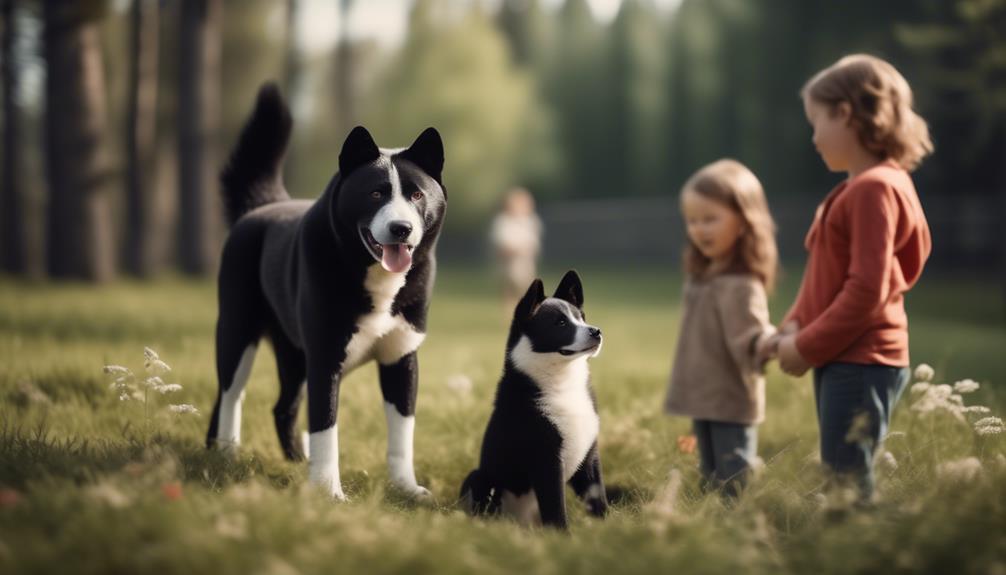
Karelian Bear Dogs vary in their suitability for different owners based on their specific needs and characteristics. While they can adapt well to apartment living, it's important to consider their energy levels and space requirements.
Owners should prioritize qualities such as being quiet, low-energy, and well-behaved to create a harmonious living environment. However, Karelian Bear Dogs may not be suitable for inexperienced dog owners or families with small children or other pets. They require strong leadership and continued training throughout their life due to their aggression and predatory instincts. Additionally, their tendency to bark or howl and potential wanderlust should be taken into account.
Owners must also meet their exercise needs and provide them with enough mental stimulation. Overall, Karelian Bear Dogs require dedicated and experienced owners who can provide them with the necessary guidance and care.
Training and Leadership Requirements
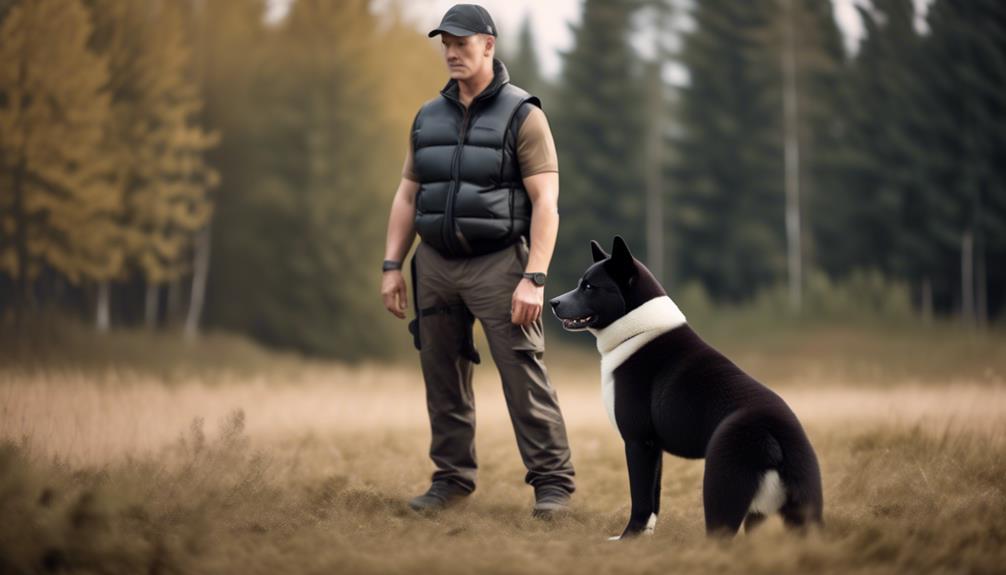
Moving on to the topic of training and leadership requirements, owners of Karelian Bear Dogs must establish themselves as strong and confident leaders to effectively guide and manage their dog's behavior. Here are four important points to consider when it comes to training and leadership for Karelian Bear Dogs:
- Consistency and Structure: These dogs thrive in an environment that provides clear rules and boundaries. Consistent training methods and a structured routine are essential for their development.
- Socialization: Early and ongoing socialization is crucial to prevent aggression and fearfulness. Expose your dog to different people, animals, and environments to help them become well-adjusted and friendly.
- Positive Reinforcement: Karelian Bear Dogs respond well to positive reinforcement techniques such as treats, praise, and rewards. Use these methods to motivate and encourage desired behaviors.
- Obedience Training: Teach your dog basic commands like sit, stay, and come. This not only ensures their safety but also strengthens the bond between you and your Karelian Bear Dog.
Behavioral Traits and Instincts
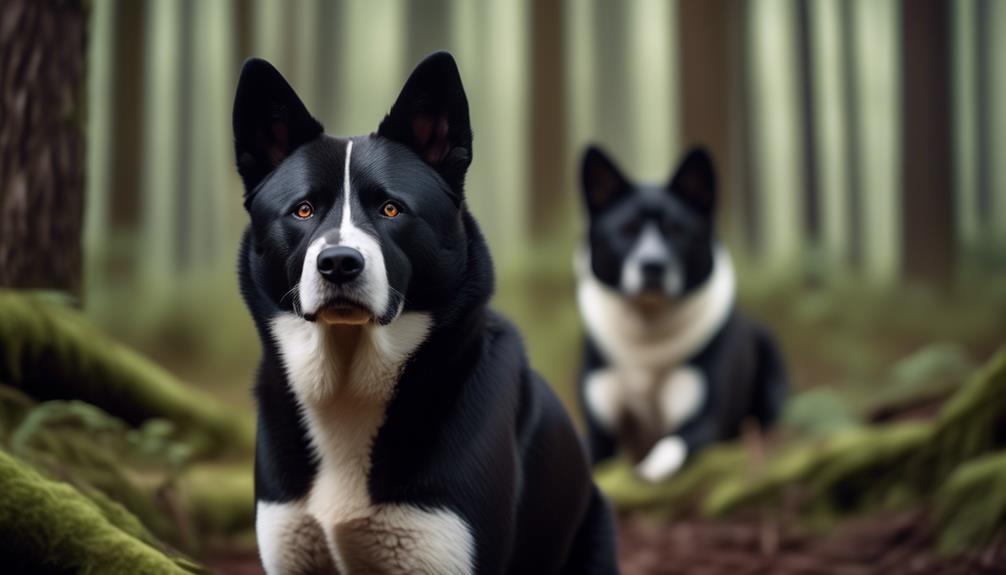
A key aspect of the Karelian Bear Dog's nature lies in its behavioral traits and instincts. This breed is known for its aggression and predatory instincts, which make it an excellent hunting dog. Karelian Bear Dogs have a strong tendency to bark or howl, making them effective at alerting their owners to potential dangers. They also have a high wanderlust potential and require regular exercise to channel their energy. Despite their intense and playful nature, Karelian Bear Dogs can be affectionate with their families when properly socialized and trained. However, they may not be suitable for inexperienced dog owners or families with small children or other pets. Strong leadership and consistent training throughout their lives are necessary to ensure their behavior remains manageable.
| Behavioral Traits | Instincts |
|---|---|
| Aggression and predatory | Hunting and tracking |
| Tendency to bark or howl | Alerting and guarding |
| Wanderlust potential | Exploring and roaming |
| Exercise needs | Channeling energy |
| Intensity and playfulness | Hunting and playing |
Barking, Howling, and Wanderlust Potential
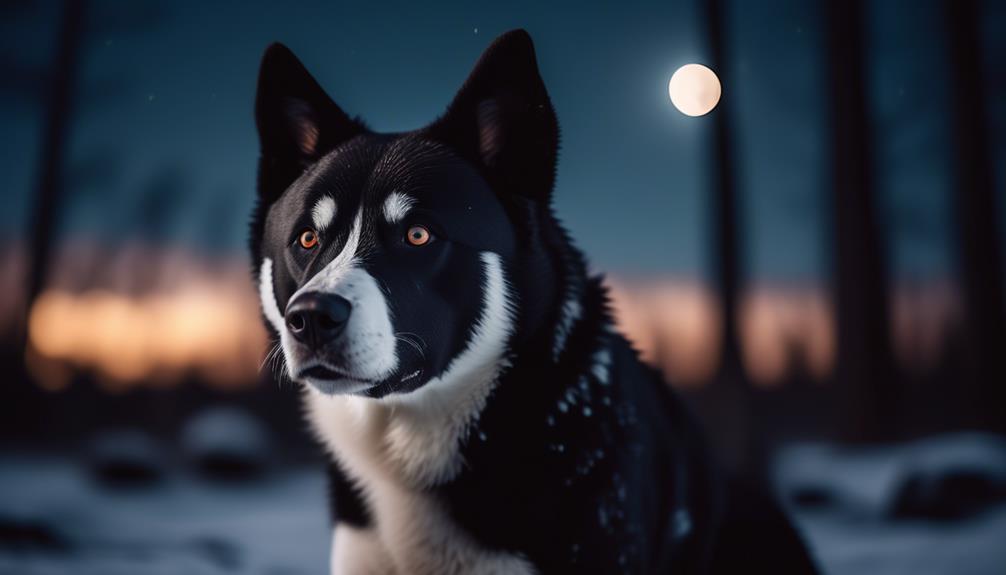
Barking and howling are common behaviors exhibited by the Karelian Bear Dog, along with a strong wanderlust potential. When it comes to vocalization, this breed isn't known for being quiet. Here are some key points to consider:
- Communication: Karelian Bear Dogs use barking and howling as a way to communicate with their owners and alert them to potential threats or intruders.
- Vigilance: Their tendency to bark and howl makes them excellent watchdogs, always on high alert and ready to defend their territory.
- Training: Proper socialization and training from an early age can help manage excessive barking and teach the dog when it's appropriate to vocalize.
- Wanderlust: Karelian Bear Dogs have a strong wanderlust potential and may try to escape if not properly secured. It's important to provide them with a securely fenced yard and always keep them on a leash during walks to prevent them from running off.
Exercise Needs and Playfulness
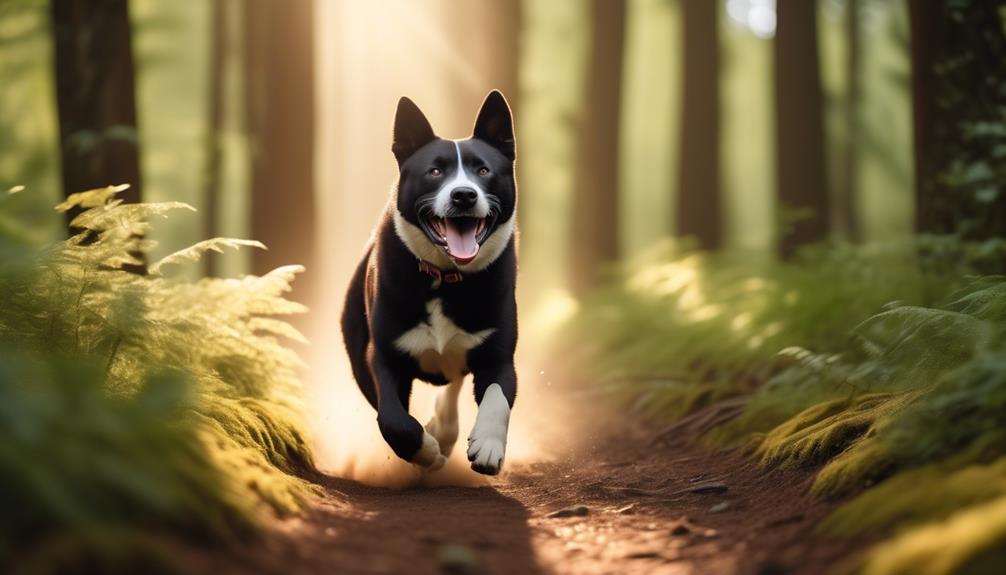
The Karelian Bear Dog's exercise needs and playfulness make them an active and lively companion. These dogs have high energy levels and require regular physical activity to keep them mentally and physically stimulated.
Daily exercise, such as long walks, jogging, or playing fetch, is essential to prevent boredom and potential destructive behavior. They also enjoy engaging in interactive games and tasks that challenge their intelligence.
Their playfulness shines through in their interactions with their owners, as they're known to be enthusiastic and spontaneous in their play. It's important for owners to provide ample opportunities for exercise and playtime to maintain the Karelian Bear Dog's overall well-being and happiness.
Care and Maintenance Requirements
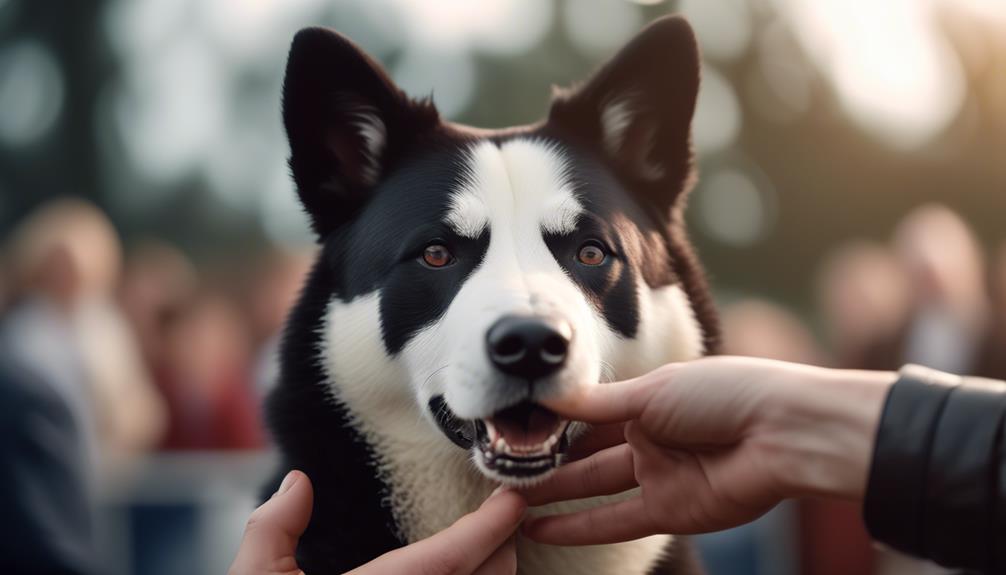
To properly care for and maintain a Karelian Bear Dog, owners must adhere to specific requirements.
These care and maintenance requirements include:
- Regular exercise: Karelian Bear Dogs have high energy levels and require daily physical activity to keep them mentally and physically stimulated. This can include long walks, jogging, or engaging in activities such as agility or obedience training.
- Proper grooming: The Karelian Bear Dog has a short, dense double coat that requires regular brushing to remove loose hair and prevent matting. They shed seasonally and may require more frequent brushing during these times. Additionally, regular nail trimming, oral hygiene, and ear cleaning are essential for their overall health and well-being.
- Socialization and training: A Karelian Bear Dog needs early socialization to ensure they're comfortable and well-behaved around other dogs and people. Obedience training is also crucial to establish leadership and control over their strong-willed nature.
- Health care: Regular veterinary check-ups, vaccinations, and preventive measures such as flea and tick control are necessary to maintain the health of a Karelian Bear Dog. Additionally, providing a balanced and nutritious diet tailored to their specific needs is vital for their overall well-being.
Health Issues and Regular Check-ups
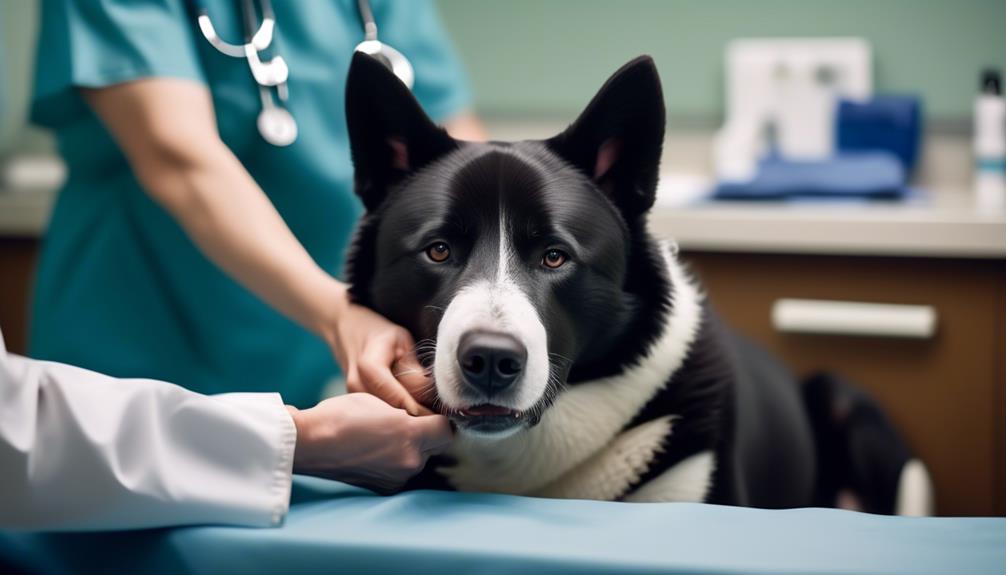
Regular check-ups and monitoring for potential health issues are essential for maintaining the well-being of a Karelian Bear Dog. As with any breed, Karelian Bear Dogs are susceptible to certain health conditions. One common issue is hip dysplasia, a condition where the hip joint doesn't develop properly, leading to pain and mobility problems.
Regular veterinary check-ups can help detect this condition early and provide appropriate treatment. Another important aspect of health maintenance is dental care. Karelian Bear Dogs are prone to dental issues, such as periodontal disease, which can lead to tooth loss and other complications. Routine dental cleanings and brushing can help prevent these problems.
Additionally, it's important to keep an eye on the dog's weight, as obesity can lead to various health issues. By keeping up with regular check-ups and addressing any potential health concerns, owners can ensure that their Karelian Bear Dogs live long and healthy lives.
Grooming, Coat Color, and Shedding
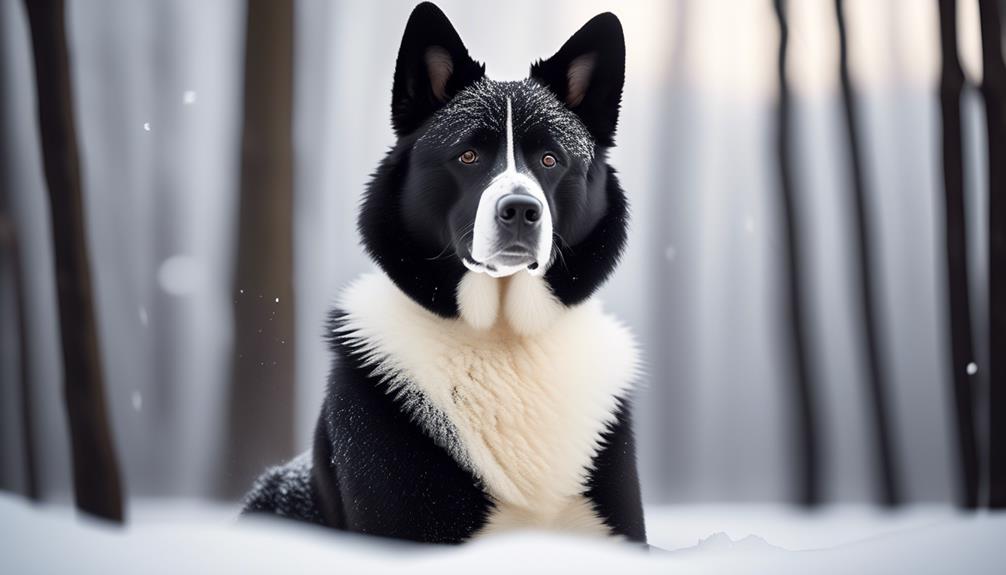
Moving on from discussing health issues and regular check-ups, grooming, coat color, and shedding are important aspects to consider when caring for a Karelian Bear Dog.
- Grooming: The Karelian Bear Dog has a short, dense double coat that requires regular brushing to remove loose hair and keep the coat clean and healthy. They're a clean breed, so bathing is only necessary when needed.
- Coat Color: The Karelian Bear Dog is known for its distinctive black and white coat color. The black color is dominant, with white markings on the chest, paws, and sometimes the face. The coat color adds to their unique appearance.
- Shedding: Like most double-coated breeds, the Karelian Bear Dog sheds moderately throughout the year. Regular brushing helps to minimize shedding and keep the home clean. They also have a heavier shedding period twice a year, known as 'blowing coat.'
- Special Considerations: It's important to note that the Karelian Bear Dog's coat isn't hypoallergenic, so individuals with allergies may experience reactions. Additionally, their dense coat provides protection in harsh weather conditions, making them well-suited for colder climates.
Interactions With Children and Other Pets
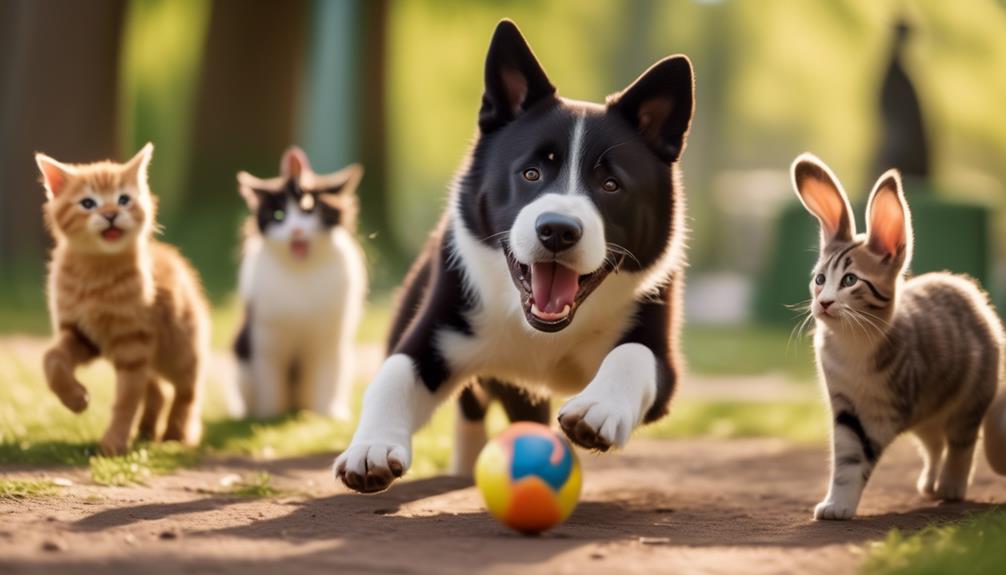
When interacting with children and other pets, the Karelian Bear Dog should be supervised to ensure a safe and harmonious environment. While this breed is generally affectionate with family, it may not be suitable for families with small children or other pets, especially if they are not experienced dog owners. The Karelian Bear Dog has strong predatory instincts and may display aggression towards smaller animals. However, with proper socialization and training, they can learn to coexist peacefully with other pets. It is important to provide strong leadership and continued training throughout their life to maintain a well-behaved and manageable dog.
Here is a table highlighting the interactions between a Karelian Bear Dog and children/pets:
| Interactions with Children | Interactions with Other Pets |
|---|---|
| Requires supervision | Requires supervision |
| May not be suitable for small children | May display aggression towards smaller animals |
| Affectionate with family | Can learn to coexist peacefully with other pets |
| Requires proper socialization and training | Requires proper socialization and training |
| Strong leadership and continued training needed | Strong leadership and continued training needed |
Frequently Asked Questions
Are Karelian Bear Dogs Good With Children and Other Pets?
Some Karelian Bear Dogs can be good with children and other pets, but it depends on their individual temperament, socialization, and training. It is important to supervise interactions and provide proper guidance for a harmonious and safe environment.
What Are Some Common Health Issues That Karelian Bear Dogs May Face?
Some common health issues that Karelian Bear Dogs may face include hip dysplasia, elbow dysplasia, and progressive retinal atrophy. Regular veterinary check-ups and proper care can help to detect and manage these conditions.
How Often Should Karelian Bear Dogs Be Groomed?
Karelian Bear Dogs should be groomed regularly to maintain their coat's health and appearance. This breed typically requires brushing at least once a week to prevent matting and shedding.
Do Karelian Bear Dogs Require a Lot of Exercise?
Karelian Bear Dogs require a lot of exercise to meet their high energy levels. Daily physical and mental stimulation is necessary to prevent boredom and destructive behavior. Regular walks, runs, and engaging activities are essential for their well-being.
Can Karelian Bear Dogs Be Trained to Be Quiet and Not Bark or Howl?
Yes, Karelian Bear Dogs can be trained to be quiet and not bark or howl. Consistent training, socialization, and proper leadership are necessary. It may be more challenging for inexperienced dog owners or families with small children or other pets.
What Are the Similarities and Differences Between the Nova Scotia Duck Tolling Retriever and the Karelian Bear Dog?
The nova scotia duck tolling retriever breed and the Karelian bear dog both hail from different parts of the world, but share some similarities. Both breeds are highly intelligent and energetic, making them excellent working dogs. However, the nova scotia duck tolling retriever is known for its striking red coat, while the Karelian bear dog has a black and white coat.
Conclusion
In conclusion, the Karelian Bear Dog is a versatile and friendly breed that can adapt well to apartment living as long as their exercise and space requirements are met. They're affectionate with their family and can be good with proper training and socialization.
However, their aggression and predatory instincts make them unsuitable for inexperienced owners or families with small children or other pets. Regular exercise, strong leadership, and continued training are essential for this breed's well-being.
Care and health considerations should also be taken into account for a happy and healthy Karelian Bear Dog.




